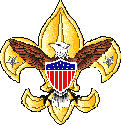| MERIT BADGES |
|
|
|
|
| Note: Eagle Required are in Italics |
"A"
American
Business
American Culture
American Heritage
American Labor
Animal Science
Archaeology
Archery
Architecture
Art
Astronomy
Athletics
Atomic Energy
Auto Mechanics
Aviation
"B"
Backpacking
Basketry
Bird Study
Bugling
"C"
Camping
Canoeing
Chemistry
Cinematography
Citizenship
Community*
Citizenship Nation*
Citizenship World*
Climbing
Coin Collecting
Collections
Communications*
Computers
Cooking
Crime Prevention
Cycling*
"D"
Dentistry
Disability Awareness
Dog Care
Drafting
"E"
Electricity
Electronics
Emergency
Preparedness**
Energy
Engineering
Entrepreneurship
Environmental
Science*
"F"
Family Life*
Farm Mechanics
Fingerprinting
Fire Safety
First Aid*
Fish & Wildlife Mgmt.
Fishing
Fly Fishing
Forestry
"G"
Gardening
Genealogy
Geology
Golf
Graphic Arts
"H"
Hiking
Home Repairs
Horsemanship
"I"
Indian Lore
Insect Studies
"J"
Journalism
"K"
"L"
Landscape Architecture
Law
Leatherwork
Lifesaving**
"M"
Mammal Study
Medicine
Metalwork
Model Design & Building
Motorboating
Music
"N"
Nature
"O"
Oceanography
Orienteering
"P"
Painting
Personal Fitness**
Personal Management*
Pets
Photography
Pioneering
Plant Science
Plumbing
Pottery
Public Health
Public Speaking
Pulp and Paper
"Q"
"R"
Radio
Railroading
Reading
Reptile & Amphibian Study
Rifle Shooting
Rowing
"S"
Safety
Salesmanship
Scholarship
Sculpture
Shotgun Shooting
Skating
Skiing
Small Boat Sailing
Soil & Water
Conservation
Space Exploration
Sports**
Stamp Collecting
Surveying
Swimming**
"T"
Textile
Theatre
Traffic Safety
Truck Transportation
"U"
"V"
Veterinary Medicine
"W"
Water Skiing
Weather
Whitewater
Wilderness Survival
Wood Carving
Woodwork
"X"
"Y"
"Z"
 Atomic Energy Atomic EnergyRequirements 1983 |
- Tell the meaning of the following: alpha particle, atom, background radiation, beta particle, curie, fallout, half-life, ionization, isotope, neutron, neutron activation, nuclear energy, nuclear reactor, particle accelerator, radiation, radioactivity, roentgen, and X ray.
- Make three-dimensional models of the atoms of the three isotopes of hydrogen. Show neutrons, protons, and electrons. Use these models to explain the difference between atomic weight and number.
- Make a drawing showing how nuclear fission happens. Label all details. Draw a second picture showing how a chain reaction could be started. Also show how it could be stopped. Show what is meant by a "critical mass."
- Tell who five of the following people were. Explain what each of the five discovered in the field of atomic energy: Henri Becquerel, Niels Bohr, Marie Curie, Albert Einstein, Enrico Fermi, Otto Hahn, Ernest Lawrence, Lise Meitner, William Roentgen, and Sir Ernest Rutherford. Explain how any one person's discovery was related to one other person's work.
- Draw and color the radiation hazard symbol. Explain where it should and should not be used. Tell why and how people must use radiation or radioactive materials carefully.
- Do any THREE of the following:
- Build an electroscope. Show how it works. Put a radiation source inside it. Explain any difference seen.
- Make a simple Geiger counter. Tell the parts. Tell which types of radiation the counter can spot. Tell how many counts per minute of what radiation you have found in your home.
- Build a model of a reactor. Show the fuel, the control rods, the shielding, the moderator, and any cooling material. Explain how a reactor could be used to change nuclear into electrical energy or make things radioactive.
- Use a Geiger counter and a radiation source. Show how the counts per minute change as the source gets closer. Put three different kinds of material between the source and the detector. Explain any differences in the counts per minute. Tell which is the best to shield people from radiation and why.
- Use fast-speed film and a radiation source. Show the principles of autoradiography and radiography. Explain what happened to the films. Tell how someone could use this in medicine, research, or industry.
- Using a Geiger counter (that you have built or borrowed), find a radiation source that has been hidden under a covering. Find it in a least three other places under the cover. Explain how someone could use this in medicine, research, agriculture, or industry.
- Visit a place where X ray is used. Draw a floor plan of the room in which it is used. Show where the unit, the person who runs it, and the patient would be when it is used. Describe the radiation dangers from X ray.
- Make a cloud chamber. Show how it can be used to see the tracks caused by radiation. Explain what is happening.
- Visit a place where radioisotopes are being used. Explain by drawing how and why it is used.
- Get samples of irradiated seeds. Plant them. Plant a group of nonirradiated seeds of the same kind. Grow both groups. List any differences. Discuss what irradiation does to seeds.
|
||||||
Last Update May 15, 2023

.jpg)
